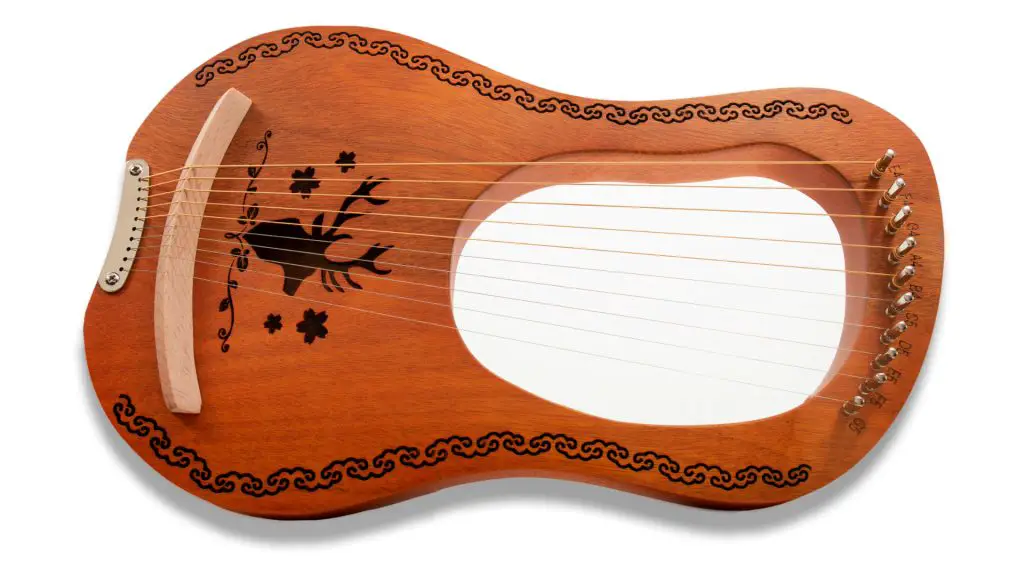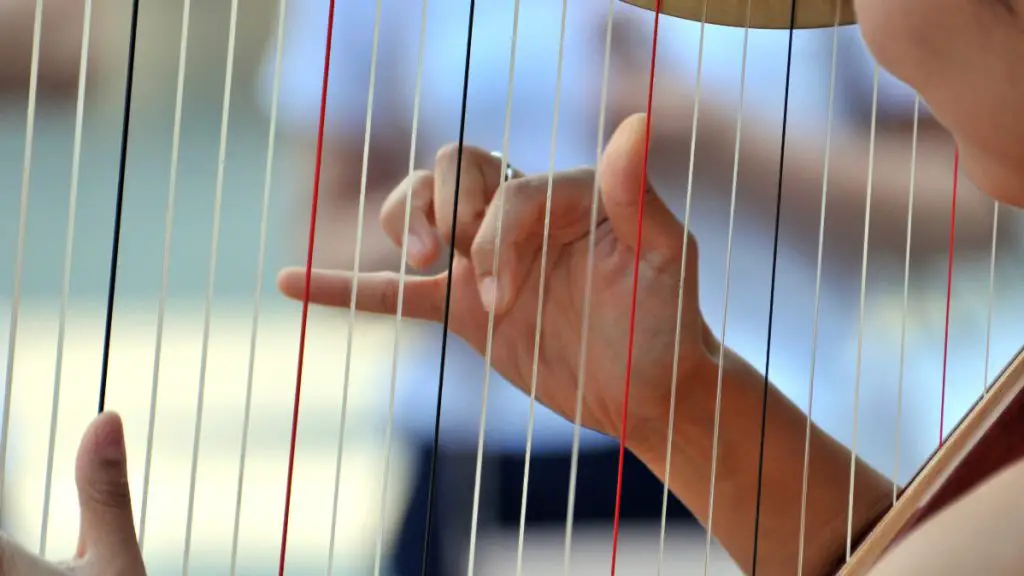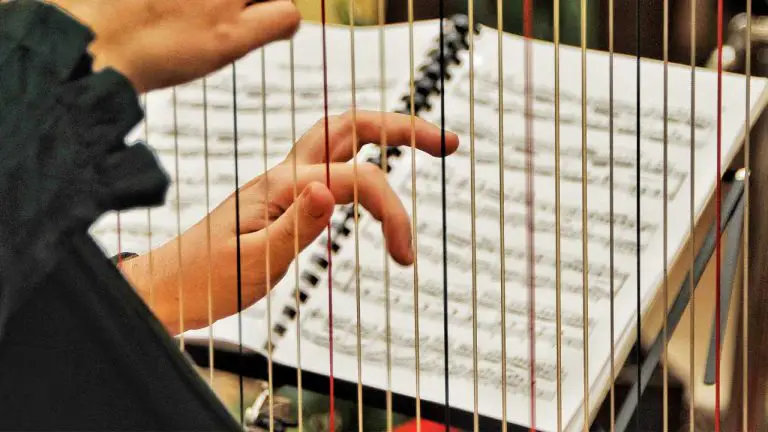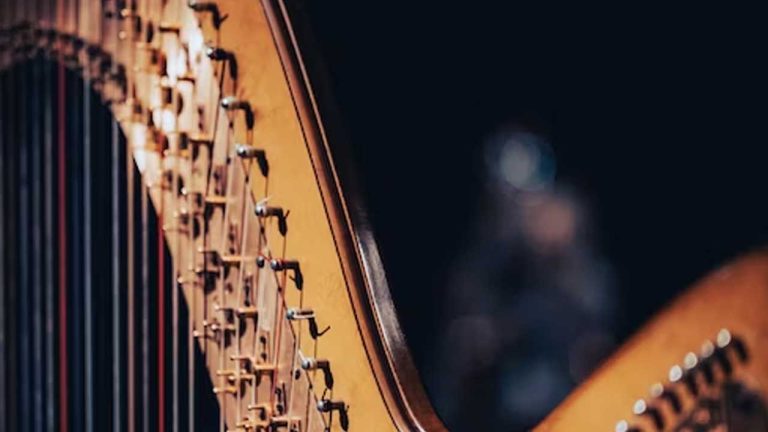What’s The Difference Between Lyre and Harp? – Unveiling the Unique Characteristics
Folkstrings.com is reader-supported. When you buy through links on our site, we may earn a small commission.
The harp and lyre are stringed instruments that have been integral to human culture for centuries.
While both have strings stretched over a frame and are played by plucking or strumming, there are distinct differences between them.
The lyre is known for its portability and was traditionally a favorite of ancient Greeks. Its structure typically involved a soundbox with two curved arms connected by a yoke, from which the strings are stretched.
Conversely, the harp usually has a larger size, a more prominent column, and can have a greater number of strings that are attached to a soundboard at the base.

Distinguishing a harp from a lyre is also a matter of examining the placement and orientation of the strings.
In a harp, the strings are perpendicular to the soundboard and can range in number from a few to several dozen, allowing for a greater range of musical pitches.
Lyres, meanwhile, feature strings that are parallel to each other and the soundboard, typically with a count far fewer than that of a harp. This structural variance contributes to the nuances in sound texture and volume between the two instruments, with harps capable of producing a more resonant, full-bodied sound.
Key Points..
- The harp and the lyre are both ancient stringed instruments with distinct physical features.
- Lyres are smaller, portable, and have fewer strings, while harps are larger with more strings and a greater range.
- Differences in string orientation and soundbox design between the two instruments influence their respective sounds and playing techniques.
Table of Contents
Historical and Cultural Context

In this section, we’ll take a closer look at the fascinating paths the lyre and harp have traversed throughout history, and their deep-rooted cultural significance that has charmed societies across the globe.
Origins and Ancient Use
The lyre and the harp share ancient lineages tracing back to some of the earliest civilizations. My journey begins with the Sumerians of Mesopotamia, where one of the earliest forms of the harp was found in the city of Ur, dating back to 2500 BC. It’s evident that the harp’s origins are intertwined with the cradle of civilization.
Moving over to ancient Egypt, harps had a significant presence, often depicted in the hands of musicians in Egyptian art around the same era. These Egyptian harps sometimes held up to 12 strings and were played in a range of social contexts.
Transitioning to the lyre, its roots also penetrate deep into antiquity. The Greeks attributed the creation of the lyre to the god Hermes. According to Greek mythology, Hermes fashioned the first lyre from a tortoise shell, beckoning a lasting emblem of music and the arts. My interest in the lyre’s ancient context led me to ancient Greece and Rome, where it was predominantly a stringed instrument of leisure, used by the Romans and Greeks to accompany poets and singers at public gatherings.
Cultural Significance
The lyre and harp weren’t just instruments; they were cultural icons.
I discovered that for the Hebrews, the harp, or ‘kinnor’—often mentioned in the Old Testament—held deep spiritual significance, symbolizing divine worship.
In Mesopotamia and Sumerian cultures, the harp was not merely for entertainment but served as an avenue for storytelling and preserving history.
Fast forward to the Middle Ages in Europe, and I observed that the harp underwent a remarkable evolution becoming a symbol of Western music culture. It was in this period that I found a clear demarcation of the harp as an instrument distinct from the lyre, particularly through its symbolism in religious and secular life.
Whether in the courts of medieval Europe or within sacred church walls, the harp provided a connection between people, their faith, and their humanity.
As for the lyre, it continued to hold its ground well into the Middle Ages. I recognized that the lyre maintained its cultural significance, often referenced by poets and scholars, which highlighted its pervasive influence in European cultural and intellectual circles.
Physical Characteristics and Design

In discussing the lyre and harp, I’ll explore their unique physical features and the nuances of their construction.
Structural Differences
Lyres:
- Feature a yoke, which is a crossbar that connects two arms projecting from the top of the soundbox.
- Typically have a hollow body, with the strings running from the yoke across a soundboard to the bottom of the instrument.
Harps:
- Possess a distinct triangular frame consisting of a neck, a soundbox, and a string arm.
- The strings are perpendicular to the soundboard and can range in number from a few to over 40 on a concert harp.
- Pedal harps, which are common in orchestras, have a complex mechanism of pedals that alter the pitch of the strings.
Material and Construction
Strings:
- Historically made from animal gut or wire, but modern harps may use nylon or other synthetic materials.
- Lyres often use similar materials but may also include metal strings, affecting the tonal quality.
Soundbox & Soundboard:
- The soundbox is generally constructed from wood, with variations in thickness and material affecting sound resonance.
- A soundboard is often a flat piece of wood that contributes to the acoustic amplification of the instrument.
In terms of electric harps, these have been developed with electronic components that amplify the sound, demonstrating how the basic design can be adapted with technology.
Lever harps, used often in folk music, have levers at the top of the strings which can be flipped to raise the pitch of the string by a half-step.
Playing Technique and Sound
In this section, I’ll guide you through the distinct playing techniques of harps and lyres and how these affect their sound qualities. My focus will be on how they’re plucked or strummed and the tonal differences you can expect from each instrument.
Plucking and Strumming
The plucking of strings is a core technique for both the lyre and the harp.
With a lyre, I often see musicians use a plectrum or pick, which can create a crisper, more precise sound compared to using just fingers. A pick can also be used for more rapid, back-and-forth strumming, delivering rhythm to accompany a singer or another instrumentalist.
In contrast, when I play the harp, my fingers are usually enough to produce the rich, warm tones it’s known for.
Pedal harps and lever harps are particularly versatile, allowing me to change pitch while playing, and the use of my hand’s positioning can subtly alter the sound’s resonant quality.
For more intricate pieces, I use both hands, where one can maintain an accompaniment while the other plays the melody or flourishes.
Tonal Quality and Range
Discussing tonal quality, I find that the lyre produces a softer, mellower sound which suits more intimate settings. Its sound is directly connected to the vibrations of the string and the hollow body it’s attached to, which acts as a resonator producing a warm vibrato.
The harp, by contrast, has a broader tonal range and can resonate louder and with more sustain due to its larger size and construction.
Pedal harps, specifically, are capable of a vast range of pitches, made possible by the pedals that can raise or lower the pitch of each string by half a step.
This creates a rich tapestry of sound, capable of high, clear notes as well as deep, resonant bass tones.
Both instruments require intricate plucking techniques, but due to their design, they serve different musical roles, with harps often serving as both solo and accompaniment instruments, whereas lyres typically provide accompaniment.
Modern Usage and Variations
When I explore the realm of musical instruments today, I find both the lyre and the harp have evolved from their ancient counterparts, each with its unique place in the modern world.
Harps, for instance, have transformed significantly, especially the concert harp, often used in orchestras. They’re known for a strong presence, thanks to their substantial size and weight, necessitating the use of a stool for proper playing posture.
Modern harps, specifically pedal harps, may have up to 47 strings and feature a straight neck and a range of different keys available at a foot’s tap, due to the pedals provided.
This multi-stringed design allows for remarkable flexibility in classical music performances.
In contrast, the lyre maintains its traditional essence but still finds its way into various musical types, with a simpler setup of typically seven to ten strings and a delightfully curved neck. Despite being lighter and therefore more portable, it has a softer volume, making it a favored choice for intimate settings or accompaniment in folk music.
My fascination is also with the modern variations in size and type: from the larger Celtic harps, resonating deeply and richly in traditional songs, to smaller lyres that I find are perfect for solo instrument pieces and personal enjoyment.
Here’s a comparison to put things in perspective:
- Concert Harp: Used in large venues like concert halls, requires a stool, characterized by a bass-heavy sound.
- Celtic Harp: Smaller than concert harps, often found in folk music settings, used without a stool.
- Lyre: More portable and suited for personal use or small gatherings, producing higher tones with a musical bow or by plucking.
Frequently Asked Questions
Exploring the differences between lyres and harps leads to various intriguing inquiries. Here are some of the most common questions I encounter on the topic.
How do the sounds produced by a lyre differ from those of a harp?
The sound of a lyre is usually softer and more mellow due to its smaller size and hollow body construction, which affects its resonance.
Harps, in contrast, have larger soundboards that enable a broader range of tonal possibilities and can produce louder, richer sounds.
What are the distinct physical characteristics of lyres and harps?
Lyres typically have two arms connected by a crossbar with strings running parallel to the soundboard, often attaching at a point near the bottom. Harps have strings that are perpendicular to the soundboard and vary in size, with some harps, like concert grand harps, showcasing extensive frames and a foot-pedal system for changing key signatures.
Was the lyre or the harp played by the biblical figure, David?
According to biblical references, David played the kinnor, which is commonly understood to be a type of lyre, not a harp.
This stringed instrument was used in many ancient cultures, including the Israelites, for various ceremonies and purposes.
What are the historical timelines for the development of lyres and harps?
The history of lyres can be traced back to ancient Mesopotamia around 3000 BCE.
Harps have a similarly ancient lineage, with evidence of their existence in ancient Egypt around the same time. Both instruments have evolved independently in different cultures throughout history.
In terms of playability and technique, how does playing a lyre contrast with playing a harp?
Playing the lyre usually involves strumming or plucking the strings with both hands, often while the instrument is held against the body.
The harp requires distinct hand positions and techniques to manage the larger number of strings, and it is usually played while stationary, either on the floor or on the lap, depending on the harp’s size.
What is considered the most similar instrument to a lyre in terms of structure and sound?
The most similar instrument to the lyre in terms of structure and sound is likely the kithara, an ancient Greek instrument that resembles the lyre.
While both are played by plucking strings, the kithara is typically larger than a lyre and was often used by professional musicians in classical antiquity.
Author Profile
-
Daniel Johnstone is an English writer with a love for stringed instruments from around the world.
He shares his love for these instruments through his writing for folkstrings.com, a website dedicated to all things related to folk string music.
Daniel's passion for music started at a young age, and he has since become an accomplished musician, playing guitar, cavaco, and recently, the harp.
His dedication to learning and sharing his knowledge of stringed instruments is evident in his insightful and engaging blog posts. Whether you're a seasoned musician or a beginner, Daniel's writing is sure to inspire and entertain you.
When he's not playing music or writing, you can find Daniel exploring new instruments and seeking out new sounds to share with his readers.
Latest entries
 AutoharpApril 4, 2024What Is the Autoharp Made Of: Exploring Its Materials and Craftsmanship
AutoharpApril 4, 2024What Is the Autoharp Made Of: Exploring Its Materials and Craftsmanship AutoharpApril 4, 2024Is Autoharp Easy to Play? Unveiling the Truth for Beginners
AutoharpApril 4, 2024Is Autoharp Easy to Play? Unveiling the Truth for Beginners AutoharpApril 4, 2024What Is an Autoharp Worth? Your Guide to Pricing and Value
AutoharpApril 4, 2024What Is an Autoharp Worth? Your Guide to Pricing and Value AutoharpApril 4, 2024Are Autoharp and Zither the Same Thing? Unraveling String Instrument Myths
AutoharpApril 4, 2024Are Autoharp and Zither the Same Thing? Unraveling String Instrument Myths
Affiliates:
This post may contain affiliate links that at no additional cost to you, the site may earn a small commission. We only recommend products we would use ourselves and all opinions expressed on this site are our own.
Accuracy Advice:
While we strive to provide up-to-date and accurate information, the content in this article may not reflect the most current research or medical guidelines. We encourage readers to do further research and consult with professionals for more personalized advice.
Our Recommendations:
The products and services mentioned in any of our articles are recommended based on our independent research and personal experience. We are not sponsored by any company. We aim to suggest products and services we believe are of high quality and could be beneficial to our readers.





